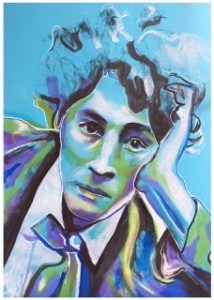
▪ ▪ ▪
This is a story about how Israel missed a golden opportunity to get the Beatles, then on the cusp of greatness, to perform live before Israeli audiences. The “Fab Four” were supposed to tour the country in 1965, concert tickets were even printed for what became a non-event. At the time the official account of why the Israeli government didn’t let the concert tour proceed was the fear of the deleterious effects that the Liverpool band were likely to have on the local youngsters. Citing the teen frenzy created by Cliff Richard’s 1963 concert hullabaloo in Israel, the authorities deny entry to the ‘Rhythm’ Beatles (as they were called in Hebrew) less they ”corrupt the minds of Israeli youth”. A follow-up investigation by a Knesset finance committee finds that “the band has no artistic merit” and reinforces the assertion that they were liable to “cause hysteria and mass disorder among young people” (Resolution 701). The local conservative press echoes the ’outrage’, describing the band’s music in hyperbolic vein as “yeah-yeah–yeah howls which are capable of striking dead a real beetle”.
 ▪ ▪ ▪ Cliff Richard: not wholesome enough for Israel?
▪ ▪ ▪ Cliff Richard: not wholesome enough for Israel? ▪ ▪ ▪
Thus the Beatles’ fans in the Jewish state never got to see the biggest band on the globe play live⍟. No doubt the desire of Israeli politicians to keep out the ‘pernicious’ influences of “sex, alcohol and rock‘n’roll” in the early 1960s was part of the thinking, however evidence emerged during the Aughts demonstrating that the (official) narratives presented in 1964/1965 were in fact apocryphal. A 2007 Israeli musical documentary Waiting for Godik by Ari Davidovich and subsequent investigations by Israel historians Yoav Kutner and Alon Gan unearths more personal considerations guiding the decision.
▪ ▪ ▪ Giora Godik, Theatrical promoter (Source: Lama Films)
▪ ▪ ▪
The true story—apparently—starts in 1962 with the mother of the Beatles’ manager Brian Epstein✥, she apparently makes an offer to Israeli music promoter Giora Godik for the not-quite-yet famous Liverpool band to perform in Israel. Godik rejects the offer and instead invites the better known-internationally Cliff Richard to do a concert the following year. Fast forward two years and Godik’s rival Israeli promoter Yaakov Uri trumps him by securing the rights to a Beatles’ concert in the country. To get back at Uri for being “one-upped”, Godik successfully lobbies the Israeli authorities to veto promoters from taking out foreign currency (thereby making the whole undertaking financially unsustainable)…Godik persuades the bureaucrats by apparently playing up the bad publicity engendered from the Cliff Richard concert. A dispute between rival Jewish music promoters – and neither of them got the Beatles!

▪ ▪ ▪
End-note: In 2008 the state of Israel issued an official apology to the Beatles via a letter to the surviving sister of John Lennon for the 1965 snub, citing lack of budget and the contemporary concerns of some members of the Knesset⌖ as the reason for pulling the tour.
 McCartney sparking a mini-Beatlemania revival in Tel Aviv (Source: abc.com.au)
McCartney sparking a mini-Beatlemania revival in Tel Aviv (Source: abc.com.au)▪ ▪ ▪
__________________________
⍟ though they did finally get to see one-fourth of the band, Paul McCartney, perform there solo in 2008, triggering a new, short-lived wave of Beatlemania in Israel
✥ an Ashkenazi Jew
⌖ at the time of the incident some insiders within the country pointed the finger at Israel’s matronly prime minister Golda Meir
༺ ༺ ༺
Articles and sites consulted
‘The Beatles and Israel’, The Beatles Bible, Updated 16-Mar-2018, www.beatlesbible.com)
‘Truth after 42 years: Beatles banned for fear of influence on youth’, Toni O’Loughlin, The Guardian, 22-Sep-2008, www.amp.theguardian.com)
‘A Beatle (finally) coming to Israel’, Matti Friedman, The Inquirer, Aug 28-Aug-2008, www.theinquirer.com



















